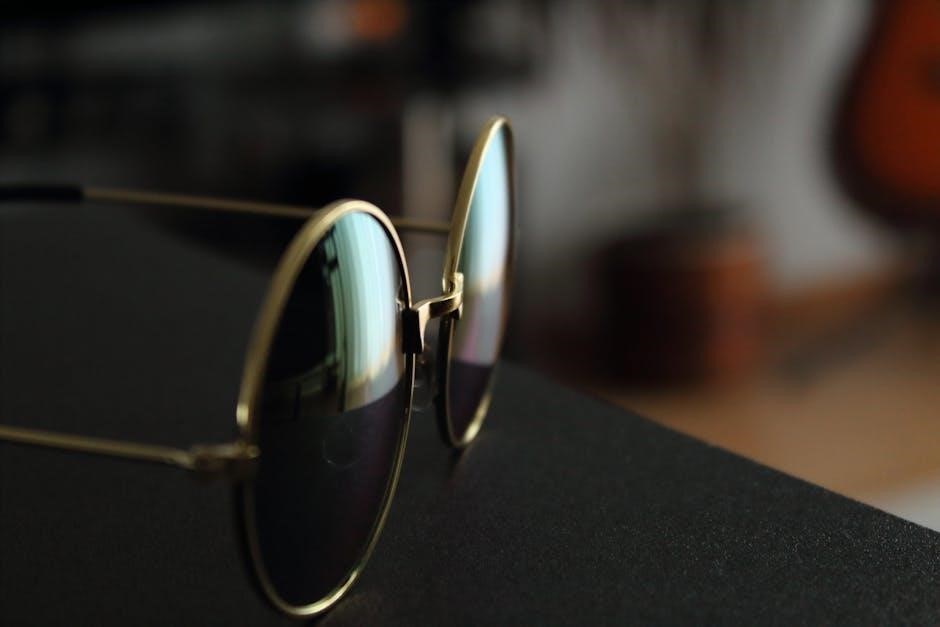Choosing the right sunglasses frame size is essential for comfort, style, and proper eye protection․ This guide helps you understand measurements, face shapes, and styles to find your perfect fit․
Why Frame Size Matters for Sunglasses
Frame size is crucial for both comfort and functionality․ Properly fitted sunglasses ensure optimal eye protection, reduce glare, and enhance vision clarity․ Ill-fitting frames can cause discomfort, slip down the nose, or leave gaps that allow light to enter․ The right size also affects the aesthetic appeal, as frames that are too large or small can throw off facial proportions․ Measuring lens width, bridge width, and temple length ensures a snug yet comfortable fit․ Additionally, frame size impacts the distribution of weight, preventing pressure points and ensuring long-lasting wearability․ Choosing the correct size is essential for enjoying your sunglasses to the fullest․
Understanding Frame Measurements
Sunglasses frames are measured by three key dimensions: lens width, bridge width, and temple length․ Lens width refers to the horizontal size of each lens, ensuring proper coverage for your eyes․ Bridge width is the distance between the two lenses, affecting how the frames sit on your nose․ Temple length measures the arms of the sunglasses, influencing how securely they fit around your ears․ These measurements are typically displayed as three numbers on the inside of the temple․ Understanding these dimensions helps you select frames that align with your face size and shape, ensuring a comfortable and stylish fit․ Accurate measurements are vital for optimal comfort and functionality․

How to Measure Your Face for Sunglasses
Measure your face width, eye size, and bridge to determine the ideal frame size for a perfect fit and optimal eye protection․
Measuring Lens Width
Measuring lens width is crucial for ensuring proper coverage and comfort․ Use a millimeter ruler to measure the width of one lens horizontally․ Typical lens widths range from 40-60mm․ For narrower faces, 40-50mm is ideal, while wider faces may require 54mm or larger․ Ensure the measurement aligns with your face width for balanced proportions․ This step helps in selecting frames that fit your eye size and provide adequate protection from UV rays․ Accurate measurement ensures the sunglasses sit comfortably and look proportionate on your face․
Measuring Bridge Width
Bridge width refers to the distance between the two lenses of your sunglasses․ To measure it accurately, place a millimeter ruler or cloth measuring tape across the bridge of your nose․ The bridge width typically ranges from 14 to 24mm, with smaller sizes suited for narrower faces and larger sizes for wider faces․ Proper bridge width ensures the frame sits comfortably and aligns with your facial features․ A well-fitted bridge prevents the sunglasses from slipping down or causing discomfort․ Measure carefully to ensure the frame complements your face shape and provides optimal support for extended wear․
Measuring Temple Length
Temple length, the distance from the temple tip to the hinge, is crucial for a secure fit․ Measure behind your ear using a ruler or cloth tape․ Standard lengths range from 135mm to 150mm․ Proper temple length ensures the sunglasses stay in place without causing pressure or slipping, especially during activities․ Longer temples suit larger heads, while shorter ones are ideal for smaller frames․ Ensure the temples are proportional to your face size for comfort and style․ Accurate measurement guarantees a snug, comfortable fit, preventing frequent adjustments and enhancing your overall sunglasses-wearing experience․

Standard Sunglasses Frame Sizes
Standard sunglasses frame sizes are categorized by lens width, bridge width, and temple length, ensuring a proper fit and style for various face shapes and preferences․
Small Frame Sizes
Small frame sizes are ideal for individuals with narrower faces or those who prefer a more subtle, minimalist look․ Typically, small frames feature lens widths ranging from 40mm to 50mm, with corresponding bridge widths and temple lengths to ensure a balanced fit․ These frames are particularly flattering for oval or heart-shaped faces, as they proportionally complement slimmer features․ Popular styles for small frames include classic aviators, round shapes, and vintage-inspired designs, which add elegance without overwhelming the face․ When choosing small frames, consider the overall proportions of your face to maintain harmony and comfort․ This size category offers both functionality and a sleek, sophisticated aesthetic for everyday wear․
Medium Frame Sizes
Medium frame sizes are the most versatile option, suitable for a wide range of face shapes and sizes․ Typically, medium frames have lens widths between 50mm and 54mm, offering a balance between coverage and style․ These frames are ideal for round, oval, and square face shapes, as they complement facial symmetry without appearing too bulky or too small․ Popular medium frame styles include wayfarers, rectangular shapes, and sport-inspired designs․ They strike the perfect balance between functionality and fashion, making them a go-to choice for everyday wear․ Medium frames are also adaptable to various activities, ensuring comfort and practicality while maintaining a stylish appearance․ This size category caters to diverse preferences and needs, making it a popular selection for many sunglass wearers․
Large Frame Sizes
Large frame sizes are designed for individuals with wider face structures, offering lens widths typically starting at 54mm and above․ These frames provide ample coverage, ensuring maximum protection from UV rays and a bold, stylish look․ Ideal for round, oval, and heart-shaped faces, large frames can create a balanced proportion․ Popular styles include oversized aviators, square frames, and trendy geometric shapes․ They are perfect for fashion-forward individuals who want to make a statement while enjoying optimal comfort․ Large frames are also great for outdoor activities, offering superior protection and a comfortable fit․ This size category is perfect for those seeking both functionality and a striking aesthetic appeal․ They cater to diverse tastes, ensuring everyone can find their ideal pair of sunglasses, regardless of face size or personal style preferences․

How to Choose the Right Frame Size for Your Face Shape
Choosing the right frame size involves matching your face shape with complementary styles․ Oval faces suit most frames, while round faces benefit from angular styles․ Square faces prefer softer shapes, and heart-shaped faces look best with frames that balance width at the top․ Proper fit enhances comfort and aesthetics, ensuring your sunglasses complement your unique features․ Understanding your face shape and frame proportions is key to making an informed decision․ This guide helps you select frames that flatter your face, ensuring both style and functionality․ By considering your face shape, you can find sunglasses that enhance your appearance and provide optimal protection․ Always prioritize comfort and balance when selecting frames, as they should complement your facial structure naturally․ This approach ensures a perfect blend of style, comfort, and practicality for everyday wear․ Your face shape is the foundation for choosing frames that make you look and feel great․
Oval Face Shape
Oval faces are considered versatile and can pull off most frame styles due to their balanced proportions․ For oval faces, frames with a lens width slightly wider than the broadest part of the face work best․ A medium to large frame size complements oval faces, ensuring the frames are not too narrow or overpowering․ Avoid oversized frames that may overwhelm the face and opt for styles that maintain balance․ The ideal lens width for oval faces typically ranges from 50-58mm, depending on face size․ This proportion ensures comfort and a flattering appearance, making oval faces adaptable to a wide range of sunglasses styles․
Round Face Shape
Round faces benefit from frames that add angles to balance their soft curves․ Rectangular or square frames with sharp lines are ideal, as they create contrast and elongate the face․ Avoid overly curved frames, as they may accentuate roundness․ For round faces, medium to large frames with a lens width of 54mm or larger often work well, ensuring the frames are proportional to the face․ Aviator or geometric styles can also complement round faces by adding definition․ Temple length should be sufficient to fit comfortably, while frame width should match the face’s proportions․ The right frame size enhances both comfort and style for round faces․
Square Face Shape
Square faces are characterized by strong, angular features, making soft, curved frames a perfect complement․ Round or oval frames can help soften the sharp angles, creating a more balanced look․ Lens widths should be proportional to the face, typically medium to large sizes, ensuring the frames don’t overpower the square features․ Frames with a narrower bridge width can also help elongate the face, while temple length should ensure a secure fit without causing discomfort․ Avoid overly angular or boxy frames, as they may harshen the square face․ Opt for frames with rounded edges or subtle detailing to enhance softness and create a harmonious balance․
Heart-Shaped Face
Heart-shaped faces feature a broader forehead and temples with a narrower chin․ Frames that balance this shape are ideal․ Rounded or oval frames can soften the wide upper portion, while cat-eye or aviator styles can draw attention downward, creating symmetry․ Lens widths should be slightly wider at the top to proportionally match the broader upper face․ Bridge width should be medium to ensure comfort and proper fit․ Temple length is crucial to secure the frames without slipping․ Avoid overly wide or decorative frames at the temples, as they may accentuate the width․ Instead, opt for frames with subtle details or acetate materials to complement the heart shape and enhance overall balance and style․
Frame dimensions include lens width, bridge width, and temple length, ensuring proper fit and comfort․ Accurate measurements are key for optimal style and functionality in sunglasses․ Lens width determines how well sunglasses cover your eyes for UV protection and visual clarity․ A narrower lens (40-50mm) suits smaller faces, while wider lenses (54mm+) fit larger faces better, ensuring adequate coverage and comfort․ Proper lens width aligns with your face shape, enhancing both style and functionality․ Measuring lens width accurately is crucial for selecting frames that fit comfortably and provide optimal protection․ Incorrect sizing can lead to poor coverage or discomfort, making accurate measurements essential for the best experience․ Lens width is the first measurement in frame dimensions, guiding the overall fit and appearance of your sunglasses․ Bridge width is the second measurement in frame dimensions, representing the distance between the two lenses․ It ensures the sunglasses sit comfortably on your nose, preventing pressure or slipping․ A wider bridge (18-22mm) suits larger noses, while narrower bridges (14-17mm) are ideal for smaller faces․ Proper bridge width enhances comfort, preventing discomfort during extended wear․ Measuring this accurately ensures the frames rest securely, avoiding irritation or movement․ Bridge width significantly impacts overall fit and wearability, making it a critical factor in choosing the right sunglasses․ A well-fitted bridge ensures long-lasting comfort and optimal performance of your eyewear․ Temple length, the third measurement in frame dimensions, refers to the arms that extend from the frame to your ears․ Proper temple length ensures a secure, comfortable fit․ Medium temples (135-145mm) are standard, while longer temples (145mm+) suit larger heads or wider faces․ Shorter temples (120-135mm) are ideal for smaller faces or children․ Correct temple length prevents slipping and distributes weight evenly, avoiding discomfort․ Measuring temple length accurately ensures your sunglasses stay in place, providing stability and all-day wearability․ This measurement is crucial for a snug, yet comfortable fit, enhancing your overall sunglasses-wearing experience and ensuring proper alignment with your face shape․ Frame width is the total measurement of the sunglasses from one temple tip to the other․ Proper proportion ensures the frames complement your face symmetry and provide even coverage․ Measure frame width by adding the lens width and the distance between the temples․ Frames that align with your face proportions offer better comfort and UV protection․ For narrow faces, narrower frames (120-130mm) are ideal, while wider faces suit broader frames (140mm+)․ Correct frame width ensures the temples fit snugly, preventing slipping and enhancing overall wearability․ Balancing frame width with face proportions guarantees a stylish, functional fit that matches your unique features and needs․ Face shape, personal style, and usage activity are key factors in selecting sunglasses size․ Proper fit ensures comfort, functionality, and aesthetic appeal, tailored to individual preferences and needs․ Your personal style plays a significant role in choosing sunglasses․ Whether you prefer bold, oversized frames or sleek, minimalist designs, your choice reflects your identity․ Consider your wardrobe and lifestyle when selecting frames․ For instance, avant-garde frames might suit fashion-forward individuals, while classic styles cater to those seeking timeless appeal․ Additionally, lifestyle factors like activity level influence decisions—sports enthusiasts may opt for durable, wraparound frames․ Ultimately, balancing aesthetics with functionality ensures your sunglasses complement both your look and daily activities, making them a seamless addition to your personal expression․ Your activity level significantly influences the ideal sunglasses frame size․ For active individuals, such as athletes or outdoor enthusiasts, frames with secure temple grips and wraparound styles are recommended to ensure stability during movement․ Larger lenses may offer better protection from peripheral light, which is crucial for activities like cycling or hiking․ Conversely, those with a more relaxed lifestyle might prefer lightweight, versatile frames that are comfortable for casual wear․ Considering how and where you’ll use your sunglasses helps narrow down the best fit, ensuring both functionality and comfort tailored to your specific needs and preferences․ Face symmetry and proportions play a crucial role in determining the ideal sunglasses frame size․ Frames should complement your facial features, balancing proportions to enhance your natural look․ For example, individuals with wider foreheads may benefit from frames with slightly taller temples to create harmony․ Similarly, those with asymmetrical faces can use frames to draw attention away from imbalances․ While face shape categories provide a guide, individual proportions, such as the distance between the temples or the width of the jawline, are equally important․ Ensuring frames align with these measurements guarantees a more tailored and flattering fit, regardless of face shape․ Measure lens width, bridge width, and temple length using a millimeter ruler or cloth tape․ Accurate measurements ensure the perfect fit for your new sunglasses․ To measure your existing frames accurately, use a millimeter ruler․ Start by measuring the lens width, which is the distance across one lens from edge to edge․ Next, measure the bridge width by placing the ruler between the two lenses․ Finally, measure the temple length from the hinge to the end of the arm․ Ensure the ruler is aligned straight for precise readings․ This method provides exact dimensions to match with new frames, ensuring a comfortable and proper fit․ Accurate measurements are crucial for selecting sunglasses that complement your face shape and personal style, avoiding discomfort or slipping․ A cloth measuring tape is a flexible and comfortable tool for measuring your face or existing frames․ To measure lens width, wrap the tape horizontally across the widest part of your face or the lens․ For bridge width, place the tape between your eyebrows and the base of your nose․ Temple length can be measured by wrapping the tape from the temple tip to just behind the ear․ Ensure the tape is snug but not too tight for accurate results․ This method is ideal for determining your frame size and ensuring a proper fit․ Cloth tapes are easy to use and provide precise measurements for selecting the right sunglasses․ Advanced tools like virtual try-on features and apps such as the GlassesUSA Prescription Scanner help determine frame size accurately, enhancing the shopping experience for sunglasses online․ The GlassesUSA Prescription Scanner is a free app that uses your smartphone camera to scan your current eyewear and extract prescription details․ This innovative tool simplifies frame size selection by providing accurate measurements, ensuring a perfect fit for new sunglasses․ It captures lens width, bridge width, and temple length, which are crucial for choosing frames that match your face dimensions․ The app also offers personalized recommendations based on your scans, making online shopping for sunglasses more convenient and efficient․ This technology eliminates the guesswork, allowing you to find frames that align with your style and fit preferences effortlessly․ Virtual try-on features revolutionize how you shop for sunglasses by allowing you to see how frames look on your face digitally․ Using facial recognition and augmented reality, these tools superimpose frames on your image, providing a realistic preview․ This feature is especially useful for online shoppers who can’t try frames in person․ By uploading a photo or using a live camera, you can experiment with various styles, sizes, and colors to find the perfect match․ Virtual try-ons enhance the shopping experience, reduce return rates, and ensure satisfaction by helping you make informed decisions about frame size and style before making a purchase․ Ignoring face shape and temple length are frequent errors, leading to ill-fitting sunglasses that compromise comfort and style․ Proper measurements are key to avoiding these mistakes․ Ignoring your face shape when selecting sunglasses can lead to a mismatched look and discomfort․ For instance, oval faces suit most styles, while round faces benefit from angular frames․ Square faces look best with soft, rounded frames, and heart-shaped faces are flattered by frames with wider bottoms․ Not considering these factors can result in frames that either overwhelm or underwhelm your features, affecting both aesthetics and functionality․ Understanding your face shape is crucial for a balanced, flattering fit․ Properly matching frames to your face shape ensures optimal comfort and style, making it a key step in choosing the right sunglasses․ Overlooking temple length is a common mistake when choosing sunglasses, as it directly impacts comfort and fit․ Temple length refers to the arms of the sunglasses that extend behind your ears․ If the temples are too short, the frames may slip down your nose, causing frequent adjustments․ Conversely, temples that are too long can dig into your skin, leading to discomfort․ Proper temple length ensures the frames stay securely in place without causing pressure․ For active individuals, longer temples may be preferable for a snug fit, while shorter temples suit those with smaller heads․ Measuring temple length accurately is crucial for long-lasting comfort and proper functionality of your sunglasses․ Avoiding this step can result in ill-fitting frames that are impractical for daily use․ Selecting the right sunglasses frame size ensures comfort, style, and functionality․ Consider face shape, measurements, and personal preferences for a perfect fit․ Use tools like virtual try-ons and size guides to make informed decisions and enjoy your sunglasses confidently․ Proper sunglasses frame size ensures comfort, protection, and style․ Key measurements include lens width, bridge width, and temple length, which vary by face shape and size․ Oval faces suit balanced frames, while round faces benefit from angular styles․ Square faces look good with soft, rounded frames, and heart-shaped faces pair well with wider bottoms․ Consider personal style, activity level, and face symmetry when choosing․ Use tools like millimeter rulers or virtual try-ons for accuracy․ Avoid common mistakes like ignoring face shape or temple length․ By balancing these factors, you can select frames that enhance your appearance and provide optimal functionality․ This guide helps you make informed decisions for the perfect fit․ For further assistance, explore tools like the GlassesUSA Prescription Scanner app, which scans your current frames for size․ Virtual try-on features allow you to visualize styles online․ Measure frames using a millimeter ruler or cloth tape for accuracy․ Visit eyewear websites for detailed size charts and face shape guides․ Check official brand pages for specific frame measurements and fitting tips․ Use online face shape analyzers to determine your face type․ Refer to eyewear blogs for trend insights and expert advice․ Lastly, consult customer support teams for personalized recommendations․ These resources ensure you find the perfect fit and style tailored to your needs․
Understanding Sunglasses Frame Dimensions
Lens Width and Its Importance
Bridge Width and Comfort
Temple Length and Fit
Frame Width and Proportion
Factors Influencing Sunglasses Frame Size
Personal Style and Preferences
Activity Level and Usage
Face Symmetry and Proportions

How to Measure Your Existing Frames
Using a Millimeter Ruler
Using a Cloth Measuring Tape
Technology and Tools for Frame Size Selection
GlassesUSA Prescription Scanner
Virtual Try-On Features

Common Mistakes When Choosing Sunglasses Size
Ignoring Face Shape
Overlooking Temple Length
Additional Resources for Further Guidance
